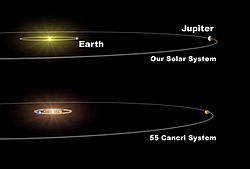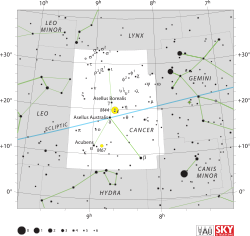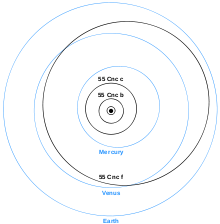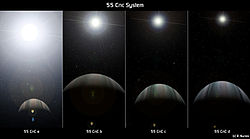
55 Cancri
Background to the schools Wikipedia
SOS Children, which runs nearly 200 sos schools in the developing world, organised this selection. See http://www.soschildren.org/sponsor-a-child to find out about child sponsorship.
| Observation data Epoch J2000.0 Equinox J2000.0 |
|
|---|---|
| Constellation | Cancer |
| 55 Cancri A | |
| Right ascension | 08h 52m 35.81s |
| Declination | +28° 19′ 51.0″ |
| Apparent magnitude (V) | 5.95 |
| 55 Cancri B | |
| Right ascension | 08h 52m 40.9s |
| Declination | +28° 19′ 59″ |
| Apparent magnitude (V) | 13.15 |
| Characteristics | |
| Spectral type | G8V / M3.5-4V |
| U−B colour index | 0.65 / 1.66 |
| B−V colour index | 0.86 / 1.21 |
| Astrometry | |
| Radial velocity (Rv) | 27.3 km/s |
| Proper motion (μ) | RA: -485.80 ± 0.97 mas/ yr Dec.: -234.05 ± 0.68 mas/ yr |
| Parallax (π) | 81.03 ± 0.75 mas |
| Distance | 40.3 ± 0.4 ly (12.3 ± 0.1 pc) |
| Absolute magnitude (MV) | 5.46 / 12.66 |
| Details | |
| Mass | 0.95 ± 0.1 / 0.13 M☉ |
| Radius | 1.152 ± 0.035 / 0.30 R☉ |
| Luminosity (bolometric) | 0.63 / 0.0076 L☉ |
| Temperature | 5373 ± 9.7 K |
| Rotation | 42.2 d |
| Age | (7.4–8.7) × 109 years |
| Other designations | |
|
BD+28°1660, Gliese 324, HD 75732, HIP 43587, HR 3522, Rho1 Cancri
|
|
| Database references | |
| SIMBAD | data |
| Exoplanet Archive | data |
| ARICNS | data |
| Extrasolar Planets Encyclopaedia |
data |
55 Cancri (pron.: / ˈ k æ ŋ k r aɪ / or / ˈ k æ ŋ k r iː /), also cataloged Rho1 Cancri or abbreviated 55 Cnc, is a binary star approximately 41 light-years away from Earth in the constellation of Cancer. The system consists of a G-type star and a smaller red dwarf, separated by over 1,000 AU (one thousand times the distance from the Earth to the Sun).
As of 2011, five extrasolar planets have been confirmed to be orbiting the primary, 55 Cancri A (the yellow dwarf). The 55 Cancri system was the first known to have four, and later five planets, and may possibly have more. The innermost planet, e, transits 55 Cancri A as viewed from Earth. The next planet, b, is close enough to edge-on that its upper atmosphere transits the star.
Distance and visibility
The 55 Cancri system is located fairly close to our solar system: the Hipparcos astrometry satellite measured the parallax of 55 Cancri A as 81.03 milliarcseconds, corresponding to a distance of 12.3 parsecs (40.3 light years). 55 Cancri A has an apparent magnitude of 5.95, making it visible through binoculars. It is just visible to the naked eye under very dark skies. The red dwarf 55 Cancri B is of the 13th magnitude and only visible through a telescope.
System components
The primary star 55 Cancri A is a yellow dwarf star of main sequence spectral type G8V. It is smaller in radius and slightly less massive than our Sun, and so is cooler and less luminous. The star has only low emission from its chromosphere, and is not variable in the visible spectrum; but it is variable in X-rays.
55 Cancri A is more enriched than our sun in elements heavier than helium, with 186% the solar abundance of iron; it is therefore classified as a rare "super metal-rich" (SMR) star. This abundance of metal makes estimating the star's age and mass difficult, as evolutionary models are less well defined for such stars. One estimate based on chromospheric activity suggests an age of around 5.5 billion years. Other studies yield age estimates of 7.4 and 8.7 billion years.
A hypothesis for the high metal content in SMR dwarf stars is that material enriched in heavy elements fell into the atmosphere from a protoplanetary disk. This would pollute the star's external layers, resulting in a higher than normal metallicity. The lack of a deep convection zone would mean that the outer layers would retain higher abundance ratios of these heavy elements.
Observations of 55 Cancri A in the submillimeter region of the spectrum have thus far failed to detect any associated dust. The upper limit on emissions within 100 AU of this star is about 850 mJy, at a wavelength of 850 μm. This limits the total mass of fine dust around the star to less than 0.01% of the Earth's mass. However, this does not exclude the presence of an asteroid belt or a Kuiper belt equivalent.
55 Cancri B is a red dwarf star located at an estimated distance of 1065 AU from the primary star, and is much less massive and luminous than our Sun. Despite their wide separation, the two stars appear to be gravitationally bound, as they share a common proper motion. There are indications that component B may itself be a double star, though this is uncertain.
Planetary system
In 1997, the discovery of a 51 Pegasi-like planet orbiting 55 Cancri A was announced, together with the planet of Tau Boötis and the inner planet of Upsilon Andromedae. The planet was discovered by measuring the star's radial velocity, which showed a periodicity of around 14.7 days corresponding to a planet at least 78% of the mass of Jupiter. These radial velocity measurements still showed a drift unaccounted-for by this planet, which could be explained by the gravitational influence of a more distant object.
This planet was designated HR 3522b by its discoverers (HR 3522 is an alternative designation for 55 Cancri), though it is more commonly referred to as 55 Cancri b. Under the rules for naming objects in binary star systems it should be named 55 Cancri Ab and this more formal form is occasionally used to avoid confusion with the secondary star 55 Cancri B.
In 1998 the discovery of a possible dust disk around 55 Cancri A was announced. Calculations gave the disk radius at least 40 AU, similar to the Kuiper belt in our solar system, with an inclination of 25° with respect to the plane of the sky. However, the discovery could not be verified and was later deemed to be spurious, caused instead by background radiation.

After making further radial velocity measurements, a planet orbiting at a distance of around 5 AU was announced in 2002. This planet received the designation 55 Cancri d. At the time of discovery, the planet was thought to be in an orbit of mild eccentricity (close to 0.1), but this value was increased by later measurements. Even after accounting for these two planets, a periodicity at 43 days remained, possibly due to a third planet. Measurements of the star suggested that this was close to the star's rotation period, which raised the possibility that the 43-day signal was caused by stellar activity. This possible planet received the designation 55 Cancri c.
55 Cancri e was announced in 2004. with 8.3 Earth masses, it is a large super-Earth which was originally thought to have an orbital period of 2.8 days, though it was later found that this was an alias of its true period of 0.78 days by observations of e transiting in 2011. This planet was the first instance of a fourth extrasolar planet in one system, and was the shortest-period planet until the discovery of PSR J1719-1438 b. The measurements that led to the discovery of this planet also confirmed the existence of 55 Cancri c.
In 2005, Jack Wisdom suggested that e actually had a period of 261 days and had a mass similar to that of Neptune in a 261-day orbit (corresponding to 0.77 AU in distance). However, the planets were found to not conflict, and hence 55 Cancri f, the first occurrence of a fifth extrasolar planet in one system, was announced in 2007. With a similar mass to c, it has a 260-day orbit, towards the inner edge of 55 Cancri A's habitable zone. The planet itself is not thought to be conducive to life, but hypothetical moons in principle could maintain at least microbial life.
The planet e's eccentricity is poorly defined; varying values between 0 and 0.4 does not significantly improve the fit, so an eccentricity of 0.2 was assumed. Taking interactions between the planets into account results in a near-zero orbital eccentricity.
The Hubble Space Telescope has measured an inclination of 53° of the outer planet d. The observed transits of e and now of b's atmosphere show that their orbits are inclined to within 9° of normal to the line-of-light. Between them, no measurement of c's nor f's inclination has been made. It had been thought that with five planets, the system cannot deviate far from coplanar in order to maintain stability.
The approximate ratios of periods of adjacent orbits are (proceeding outward): 1:20, 1:3, 1:6, 1:20. The nearly 1:3 ratio between 55 Cancri b and c is apparently a near resonance, rather than a genuine mean motion resonance.
More planets are possible within the stable zone, between f and d at 0.9 to 3.8 AU with eccentricities below 0.4. Given hypothetical planet g of up to 50 Earth masses, stable mean motion resonance regions lie at 3f:2g, 2g:1d, and 3g:2d. As for the space outside d's orbit, its stability zone begins beyond 10 AU, though there is a stability zone between 8.6 - 9 AU due to a 2:1 resonance.
| Companion (in order from star) |
Mass | Semimajor axis ( AU) |
Orbital period (days) |
Eccentricity | Radius |
|---|---|---|---|---|---|
| e | 8.63 ± 0.35 M⊕ | 0.01560 ± 0.00011 | 0.736537 ± 0.000013 | 0.17 ± 0.04 | 2.00 ± 0.14 R⊕ |
| b | 0.825 ± 0.003 MJ | 0.1148 ± 0.0008 | 14.6507 ± 0.0004 | 0.010 ± 0.003 | — |
| c | ≥0.171 ± 0.004 MJ | 0.2403 ± 0.0017 | 44.364 ± 0.007 | 0.005 ± 0.003 | — |
| f | ≥0.155 ± 0.008 MJ | 0.781 ± 0.006 | 259.8 ± 0.5 | 0.30 ± 0.05 | — |
| d | ≥3.82 ± 0.04 MJ | 5.74 ± 0.04 | 5169 ± 53 | 0.014 ± 0.009 | — |
Communication
A METI message was sent to 55 Cancri. It was transmitted from Eurasia's largest radar – 70-meter (230-foot) Eupatoria Planetary Radar. The message was named Cosmic Call 2, it was sent on July 6, 2003, and it will arrive at 55 Cancri in May 2044.



